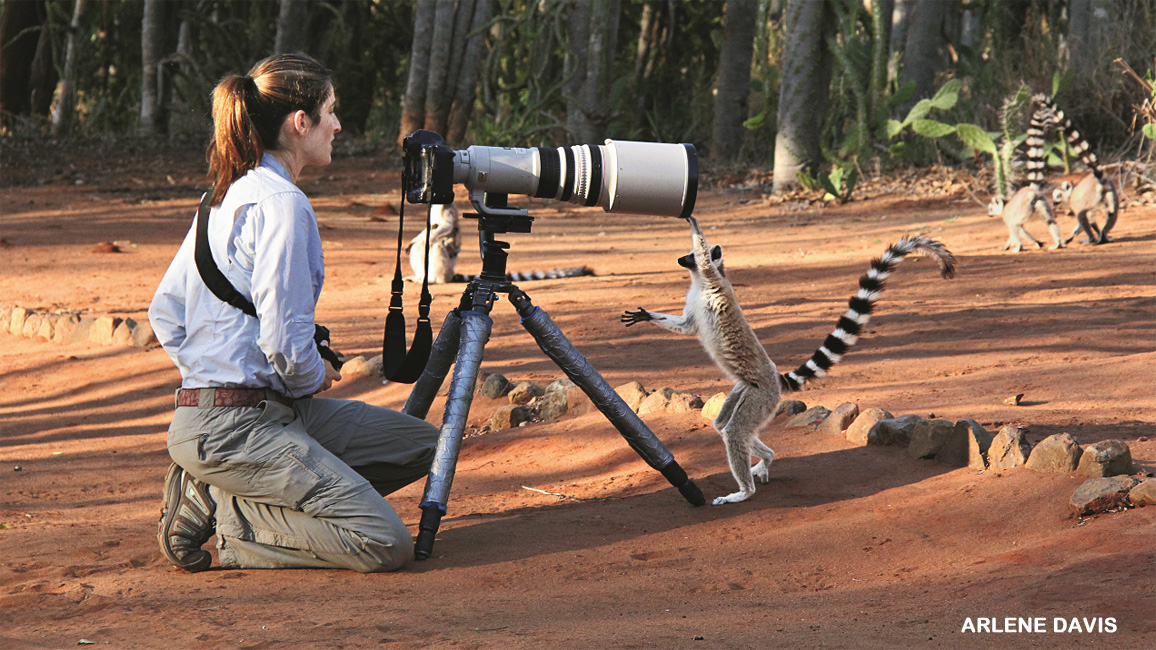
Women Working for Wildlife
By Suzi Eszterhas
I got my first camera when I was six. As a kid, my favorite thing was reading stories about baby animals. I always imagined myself watching them in the wild. I also imagined that I would someday take photos for Ranger Rick. And that’s exactly what I’ve done—a dream come true!
That’s me in the photo above. I was in Madagascar to photograph a group of ring-tailed lemurs for a story in the May 2014 issue of Ranger Rick. That one lemur was very curious about my camera. It came up to check it out, and then quickly ran off.
One of the best parts of my job is traveling the world and meeting people who help all kinds of wildlife. Many of those people are women. And did you know that March 8 is International Women’s Day? Let’s celebrate by giving a huge shout-out to all the amazing women who work so hard to make this world a better place for wildlife. Let me introduce you to just a few of those I’ve been so lucky to work with.
PATRICIA SWIFT
Currumbin Wildlife Hospital
Australia
One of the things I always notice about Patricia is her nonstop sweetness. That smile you see is for real—and she’s always smiling! Here, she’s checking the heartbeat on a shy echidna (uh-KID-nuh). A scared one rolls up into a spiky ball. But because Patricia is super gentle, you can see this one’s tiny face, long snoot, and feet. Every year, this amazing little hospital treats hundreds of weird and wacky animals and returns them to the wild. Can you tell it’s Patricia’s dream job?

CHEYNE FLANAGAN
Koala Hospital
Australia
This koala, named Buster, got a knee injury—possibly from being hit by a car. Cheyne is just sharing a sniff with him so he’ll relax. It’s the way koalas say “Hi, friend!” when they greet each other. Buster was pretty chill with people, but he was about to have his injury treated. Cheyne was just trying to settle him down. And it worked!
LAURIE MARKER
Cheetah Conservation Fund
Namibia (Africa)
Meeting a cheetah up close like this is not normal. But this one is totally tame. His mom was killed when he was a tiny cub. By the time Laurie adopted him, he was too used to people to learn how to live wild. So, Laurie raised him to be a special teaching assistant. Here, she introduces him to a student. It’s just one of the ways she helps the local community learn more about these endangered wild cats—and how to safely share the land with them.
LO HSUAN-YI
Taipei Zoo
Taiwan (Asia)
A baby pangolin, named Gung-wu, was born in this zoo. But she had trouble nursing, so Hsuan-yi became her round-the-clock new mom. She’d tend to Gung-wu all day at the zoo. Then she’d strap the baby in a bin on the back of her motorbike and drive it home for the night. She’d wake up every three hours to feed it some milk. Then she’d get up each morning and drive Gung-wu back to the zoo. It was a 24/7 job for Hsuan-yi. And Gung-wu clung to her the way any baby pangolin would cling to its pangolin mom.
FRANCY SÁNCHEZ
Proyecto Tití
Colombia (South America)
This cotton-top tamarin is an endangered little monkey in a small area of tropical forest. Francy is trying to coax it down with a piece of banana so she can quickly and safely check it over. Francy works in the wild for a group that keeps track of the remaining cotton-tops. (Proyecto means “Project” and Tití is the tamarins’ local name.) The group also teaches the local people how to protect the cotton-tops and their forest home.

BELINDA MACKEY
Grevy’s Zebra Trust
Kenya (Africa)
Why is Belinda holding up that antenna? She’s searching for signals coming from a GPS collar on one of the zebras in the background. They’re Grevy’s zebras, and there aren’t many of them left. They live in dry grasslands that have become ever drier, so they must roam in search of water. The local people need water for themselves and their cattle, too. Belinda works with the community to find ways people and wildlife can share the land and water. And by following the endangered zebras’ movements, she can keep track of how they’re doing.
ISABEL LUEVANO
International Bird Rescue
California (USA)
This black-crowned night heron chick had fallen from its nest high above a busy road. It was brought to the rescue center, where Isabel could comfort it and examine it for injuries. Isabel loves her little “baby dinosaurs.” During nesting season each year, a few hundred of these chicks might get rescued. Isabela would inspect each one. Then she’d help care for them all until they were well and old enough to be released.
IBU SUMI
Orangutan Foundation International
Borneo (Indonesia)
It’s hard not to smile when a baby orangutan is clinging to you! Sumi knows how to play the mom at the Orangutan Care Center. It’s where injured or orphaned orangs are rescued and cared for. Sumi also visits the nearby “Learning Forest” with her team. There, the caretakers teach the little ones how to play the orangutan way. That will help them when they’re old enough to live in the wild. Sumi is 100% dedicated to these endangered apes.
REBECCA CLIFFE
Sloth Conservation Foundation
Costa Rica (Central America)
I’ve had so many incredible photo-shoot adventures with women all around the world. Some of the most fun ones were with my friend Becky. As you might guess, sloths are her thing. Want to know what she’s doing to help them? Discover the whole story in next month’s issue of Ranger Rick!

















